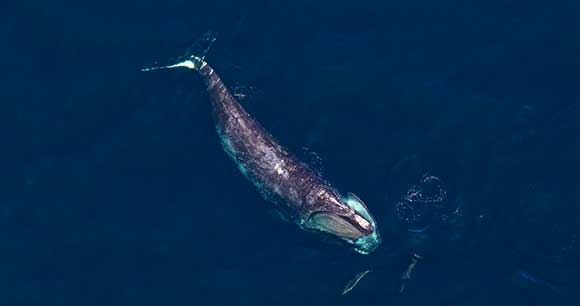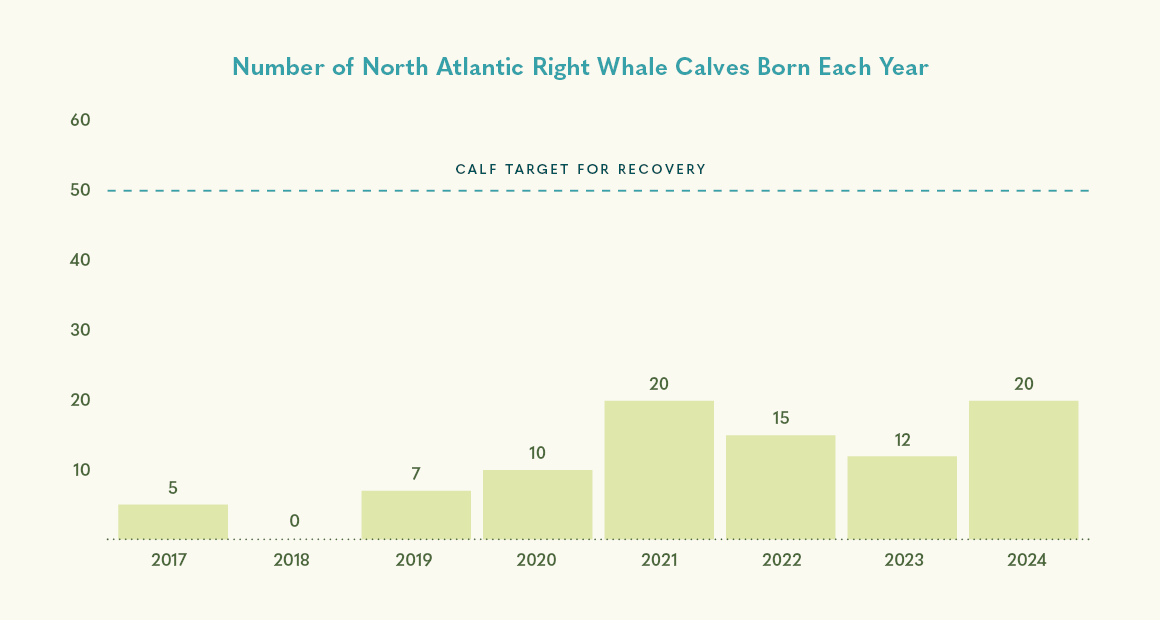
The North Atlantic right whale (Eubalaena glacialis) is a baleen whale species that inhabits waters off the East Coast of the United States and Canada. During the summer, these whales migrate north to feed in the cooler waters off New England and Canada, before migrating south in the winter to warmer waters off the southeastern United States to mate and give birth.
The North Atlantic right whale is one of the most endangered whale species in the world and is currently on the brink of extinction. There are only 370 individuals remaining in the population, approximately 70 of whom are reproductive females, and scientists fear the species could be functionally extinct in 10–15 years.
Given such low numbers, the death of even one whale per year to human causes can prevent the population from recovering. At present, North Atlantic right whales are dying from human causes faster than they can reproduce. Under the current circumstances, 20 births in a calving season would be considered a productive year. However, scientists say we need at least 50 births per year for several years in a row to stop the decline and allow for recovery.

The species has been listed as endangered under US law since 1970. North Atlantic right whales were driven to the brink of extinction once before by commercial whaling. By the early 1900s, perhaps a hundred or fewer remained. In 1935, an international agreement banned hunting of all right whale species, and the population began to slowly recover. By 2010, the population had grown to about 480 North Atlantic right whales. Since that time, however, other human threats have caused the population to once again decline.
The two primary threats today are accidental entanglement in commercial fishing gear and collisions with vessels. Fishing gear using vertical buoy lines—where a trap set at the bottom of the ocean connects via rope to a buoy at the surface—presents a major entanglement risk. Entangled right whales may end up dragging hundreds of pounds of fishing gear, inhibiting their ability to feed, reproduce, or move freely through the water. Fishing gear can also cause cuts and other injuries, and over time, entangled whales may die a slow death from starvation and infection. Scientific analysis estimates that 86 percent of North Atlantic right whales have been entangled at least once, and 60 percent have been entangled at least twice, with some entangled as many as nine times. This is both a conservation and animal welfare issue.
North Atlantic right whales are also vulnerable to vessel strikes because their habitat overlaps with some of the busiest shipping lanes in the world, and they often swim slowly, just beneath the water’s surface, where boaters cannot easily see them. Collisions with vessels of any size can lead to blunt force trauma, propeller cuts, broken bones, and death.
Females and calves are particularly vulnerable; data calculated by AWI show that calves have a 1 in 11 chance of being struck and injured before they turn a year old.
Warming oceans brought on by climate change have exacerbated these threats by changing the location and abundance of North Atlantic right whale prey, making it harder for the whales to find food and exposing them to greater threats. This is one of the main reasons the population’s birth rates have been decreasing; right whales are giving birth every 7–10 years now instead of their potential of every 3–4 years.
North Atlantic right whales, like other large whales, help maintain healthy and diverse marine ecosystems. Their waste products provide nutrients that support the growth of plankton, and as they migrate and move up and down in the water column, they fertilize the habitats they move through. This process is particularly important, as ocean phytoplankton captures carbon dioxide and generates much of the atmosphere’s oxygen.
AWI works to protect the North Atlantic right whale by advocating commonsense measures to prevent fishing gear entanglements and vessel strikes. We support the transition to ropeless fishing gear, which removes vertical lines from the water column, and we work to hold accountable sustainable seafood ecolabels that certify fisheries impacting right whales. Finally, we work with wildlife champions in Congress to call for much-needed funding for research, monitoring, and the development of technologies to address the species’ leading threats.